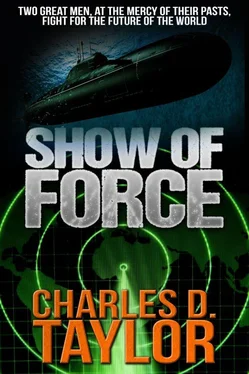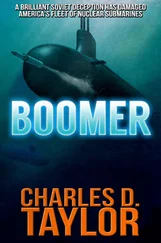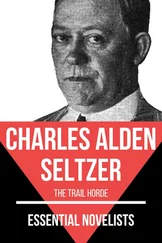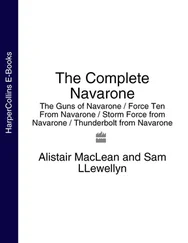Four destroyers, each with a bone in its teeth, raced across the blue water in a ragged line abreast, two thousand yards from each other. The plan was to sweep over the sub's last position with the middle of their line. This gave Carter a mile and a half on either side of the datum, plus another mile and a half on the beam of the end ships if sonar conditions were accurate. The fringes of their sweep would be covered by helicopters just now flying by on their way to that invisible point in the ocean. Farther out, the fixed-wing aircraft had already established sonobuoy patterns in case the sub escaped the close-in search that Carter had ordered.
It was deceptively beautiful as the formation charged into a golden sun that was now settling quickly toward the flat horizon. They were too far from land for birds, and their departure had been fast enough to leave the ubiquitous garbage-hunting gulls with the remainder of the task force.
David Charles felt Bagley shuddering under his feet as the screws continued to increase their revolutions. Each motion of the ship was now magnified by its speed, and the helmsman had only to shift the wheel the slightest bit to feel his rudder respond. This was what destroyers were built for. The bridge was comfortable for the GQ team, even in their life jackets. The breeze sweeping across them was now close to thirty-two knots. But David knew from past experience the heat and the stench of the engineering spaces and the human smell of other groups sealed into their spaces until the captain ordered otherwise.
No air moved in CIC. Sweaty faces were outlined in eerie shades by the green reflection from the radar screens., Voices were quiet as each man strained to listen to the sonar pinging from the open compartment to the rear of their own — the sharp sound as the signal expanded from the sonar dome, and perhaps the anticipated response when contact was made.
Carter paced the bridge looking from David, reporting all-important items that came over his headphones, to the overhead speaker in the corner that Frank Welles would use only once when he reported the initial contact. But the speaker remained silent, and Carter had to be satisfied as David reported the distance to datum every thousand yards, and relayed the information from combat as Jerry Burchette resumed control of the aircraft already on station. Somehow, it didn't seem quite right; it was too similar to the exercises they participated in every month. The only real difference was the captain's pacing, which David thought very uncharacteristic of the man. The lookouts swept the ocean's surface on their 360-degree vigil, knowing that any smart submarine would be at least a hundred feet below their line of sight.
"Captain, CIC reports one of the trackers had sighted what they believe to be. garbage off our port bow." All binoculars swept in that direction.
"Ask the pilot if he can identify anything in it," Carter requested.
David relayed this to Combat, waited for a moment, listened, spoke into the headset, listened again, and turned to Carter with a grin. "Trojans, Captain! Pilot says he can identify them from any height."
There were just a few amused snickers, and then the bridge burst into laughter when Carter stopped his pacing to say, "Tell him it must be from Bagley. We passed through this area last night, and we're a very happy ship."
The ice was broken. The unknown for the last couple of days had been put in its place. Carter stopped pacing and moved over to his chair. The team was ready for a real target. Their captain had been put at ease by a pilot with a sense of humor.
A few moments later, David reported, "Passing over datum, sir. Combat recommends we begin a wider sweep to the northwest since the sub's last course seemed to be to the west. Mr. Bradick says the sub wouldn't keep the same course and he wouldn't reverse it. He may head toward the northwest hoping he can find some temperature gradients if he can get close to the Gulf Stream tonight.
Carter paused for a moment. "Okay. Tell Mr. Bradick to pick a course for us and have Mr. Welles recommend a speed that will maintain a good sonar range. I want to open the distance between the cans to three thousand yards. I also want to have helos dipping well ahead of us. Maybe their pinging will scare the son of a bitch right down our throats."
The four destroyers opened their formation, with Bagley the farthest ship to the southwest. The sun was about to touch the water's edge, preparing to evaporate in a cloud of steam. It would leave them with another two hours of light but without the blinding glare. The breeze was picking up from the south, not enough to raise whitecaps but enough to further the cooling that would gradually seep into the hidden metal recesses of the Bagley. A bit less than five minutes had passed before the speaker over the captain's head erupted with Frank Welles's voice. "I have a solid contact bearing thirty degrees to port, approximately four thousand yards. No classification yet, but there's something more than a school of fish there."
There it was. Contact. Perhaps not the submarine they were looking for, but whatever it was, it was close to where Bradick had anticipated.
Each man aboard the submarine heard the pinging of the Bagley's sonar on the pressure hull. Even before they had been found, the approaching high-speed noises of the destroyer's screws were evident. In advance of that first ping, Kupinsky gave orders to change course 110 degrees, increased his boat's speed to its maximum, then took it down another 150 feet, hoping against hope for the miracle of a temperature gradient that would deflect Bagley's sound beam.
Within moments, Welles classified the contact as a probable submarine, and he and Andy Bradick concurred on the submarine's course and speed at almost the same time. "Both sonar and Combat report the contact has turned almost due south, Captain. They have a port-quarter aspect… contact moving at.eleven knots… he seems to have picked up speed."
"David, ask Andy for a course to pass astern of the contact. Tell him my rudder is left… left standard rudder."
"Combat recommends two-zero-five at fourteen knots, sir."
"Come to course two-zero-five." Carter turned to his OOD. "Bob, I want you to set up a pinwheel around that boat with us as guide on the western edge. Add the others according to their current positions. When you're all set, I'll give the word to execute." To David, "Tell Mr. Welles that we will shortly be passing astern of his contact. When we're close, I want him to listen in the passive mode for just a minute. I want to try to classify screw noise if we can. Tell Combat to explain to all the aircraft in plain language what we're doing. As soon as we have a better classification, we'll assign them stations."
The contact did not maintain course and speed to satisfy Sam Carter, which was no great surprise since its movements seemed too well planned. Combat was tracking it step by step with a direct feed-in from sonar. As often as Frank Welles noted changes in the return echo, Andy Bradick had a new course for Carter. They had been a team for too long to be fooled by simple evasive tactics. Bob Collier was able to adjust his course and speed in tandem with the recommendations of the others. As they passed astern of the contact, its propellers gave it away and a confirmed submarine was radioed back to Banker. Within a few moments the information would be encoded and sent to the Joint Chiefs of Staff, and they would interrupt Mr. Kennedy's hastily grabbed sandwich to inform him that the first Russian submarine was now being held down by units of Task Group Alpha… professionals in the art of sub hunting.
It was obvious to Carter that they had a diesel sub. A nuclear boat would already have raced away from the slower destroyers.
Читать дальше












